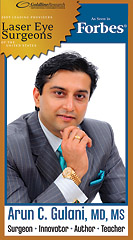
PROTECT YOUR VISION ON THE LINKS

Golf is a sport that is visually demanding besides being technique and technology dependent.
I like to classify vision demands used in golf into a couple of categories for ease of understanding and future surgical correction:
- Quantity of vision such as 20//40, 20/20, etc.
- Quality of vision such as:
*Contrast sensitivity to decipher different levels of visual inputs in different *lighting conditions;
*Depth perception to best apply learned techniques in three dimensions;
Spatial resolution to plan and direct putting and long drives effectively.
Finally, all of the vision inputs and resolutions along with eye-hand coordination lead to perfect execution for what the mind has planned in the mentally intuitive sport.
This is true for novice as well as professional golfers alike.
Vision Errors:
Golfers who wear contact lenses or glasses may have nearsightedness (Myopia), farsightedness (Hyperopia), or astigmatism (football-shaped cornea).
With current technology, we the minutest level of vision involvement can be measured and diagnosed, then corrected using computer drive, micron-precision lasers as in Lasik surgery. "No-blade" techniques allow for painless surgery with rapid healing and predictable outcomes
As golfers advance in age beyond 40 years, they need reading glasses because the natural lens inside the eye stops zooming (no more “Tele” and “Wide” zooming like a camera does). Then they need to keep their scorecards at further distance with their arms outstretched to read or record. That condition called Presbyopia can be treated with new- generation laser techniques.
With further aging (early 60s), the vision gets cloudy and dim because of cataracts, a cloudy transformation of our natural crystal clear lens. Such cataracts can be removed using modern laser techniques and be replaced by an artificial lens implant that can in most cases allow sight without glasses at distance and near. Such lens implants can be monofocal, multifocal like ReStor, Rezoom, Tecnis or accommodative like Crystalens.
Additionally, cataract surgery can now be planned as two stages. After cataract surgery, patients can undergo Lasik surgery to correct any residual astigmatism to completely fix the optics of the eyes for glasses-free vision.
Additionally, patients who have undergone previous cataract surgery and did not have a choice of these advanced, multifocal/progressive lens implants at that time can now undergo New Generation Lasik surgery to help them get rid of glasses altogether.
Golfer’s Eyes:
Another condition rampant among golfers is a Pterygium. A yellow-red lesion on the white of the eye can start as a cosmetic blemish and become an unsightly wedge-shaped growth. If left untreated it may eventually cover the cornea of the eye and harm vision. The condition is usually the result of exposure to sun, a professional hazard for golfers.
Many golfers have Pterygiums and our advice is to wear sunglasses with ultraviolet protection to prevent further damage. When they are advanced, though, they require surgery using “No-Stitch” surgical technique using Human placenta.
So before heading out to golf, as you apply your sunscreen, do remember to protect your eyes with sunglasses and a wide-brimmed hat if possible. It may ultimately contribute to a healthier “Fashion on the Fairway."